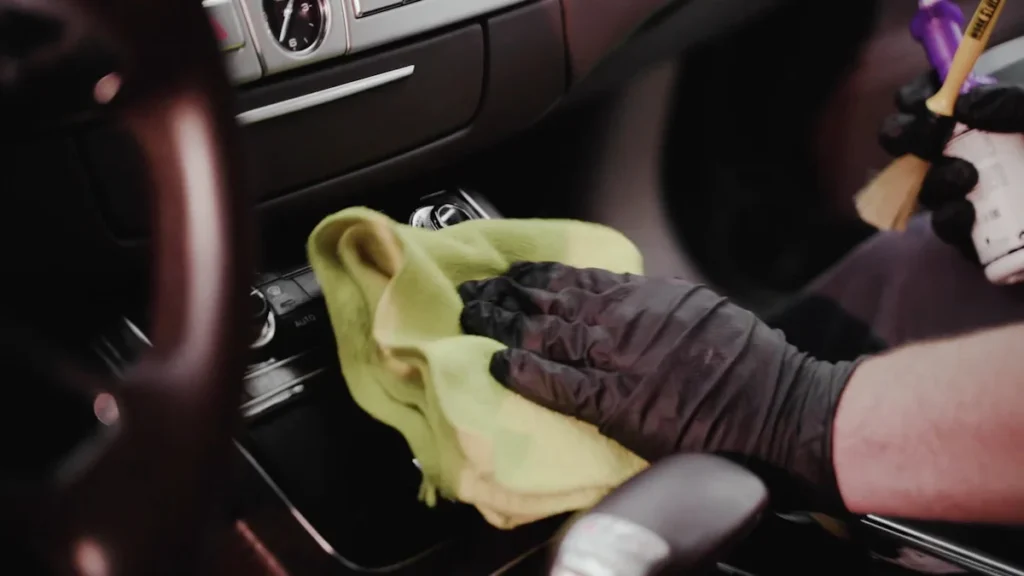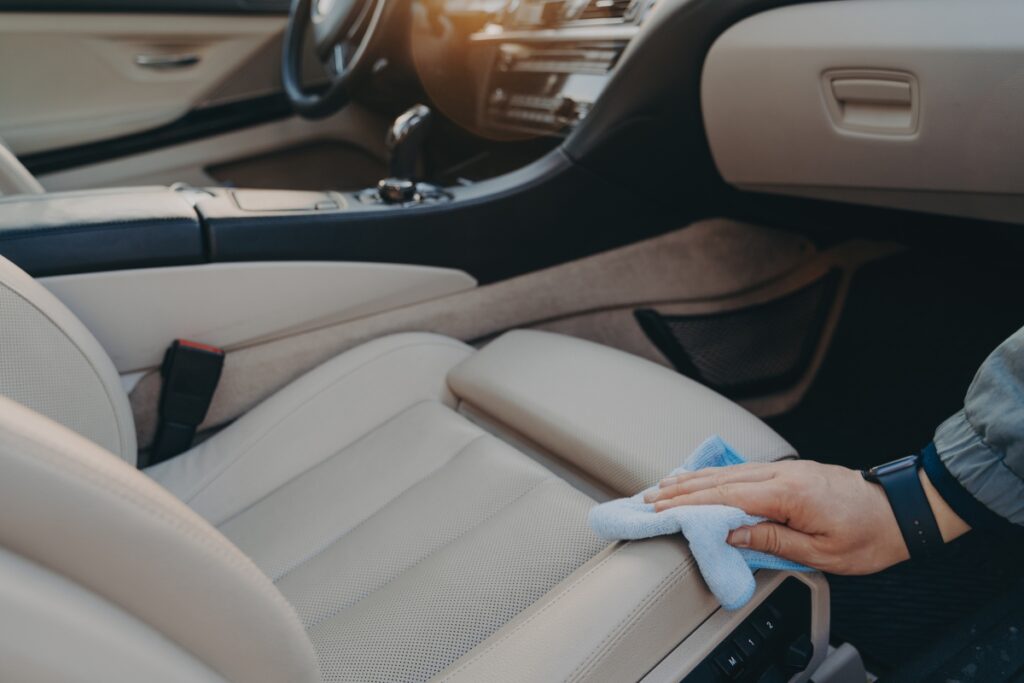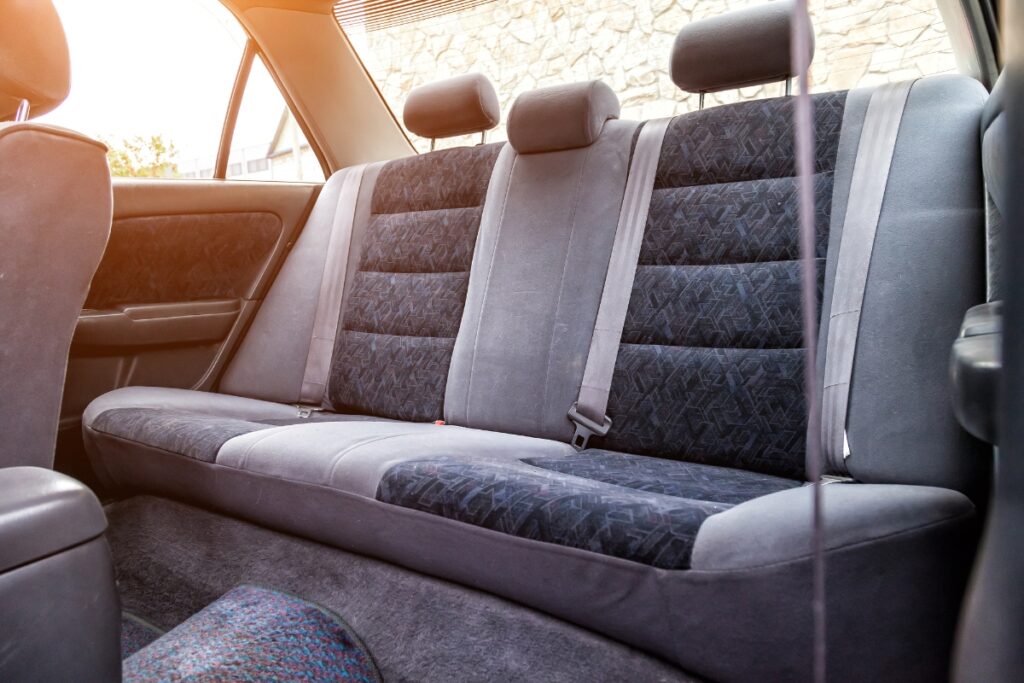
Keeping your car seats clean is more than just about appearances. Dust, dirt, and bacteria build up over time, especially with frequent use. Studies have even found that children’s car seats can harbor high levels of harmful bacteria. Using the wrong cleaning products risks damaging the material or leaving residues that reduce comfort and longevity. To protect your car seats and maintain a healthier environment, you need to choose the right products. Start by identifying the material of your seats. This simple step ensures you select safe and effective solutions tailored to your car’s interior.
Key Takeaways
- Identify your car seat material—fabric, leather, or vinyl—to choose the right cleaning products and avoid damage.
- Use specialized cleaners for each material: fabric seats benefit from upholstery cleaners, leather requires leather-specific products, and vinyl needs vinyl-safe cleaners.
- Always vacuum your seats before applying any cleaner to prevent dirt from scratching the surface and ensure effective cleaning.
- Perform a spot test on a hidden area before using any cleaning product to avoid discoloration or damage.
- Regular maintenance, such as conditioning leather and applying fabric protectants, extends the life of your car seats and keeps them looking new.
- Act quickly on stains by applying cleaner directly to the affected area and blotting gently to avoid spreading the stain.
- Allow your car seats to air dry completely after cleaning to prevent moisture buildup, which can lead to mold and odors.
Identify Your Fabric Car Seats Material
Understanding your car seat material is the first step in selecting the right cleaning products. Each material—fabric, leather, or vinyl—has unique characteristics that require specific care. By identifying the type of material, you can avoid using products that might cause damage and ensure your seats remain in excellent condition.
How to Determine the Material Type
Identifying your car seat material is easier than you might think. Start by checking your car’s manual, which often specifies the type of upholstery used. If the manual isn’t available, inspect the seats closely:
- Fabric Seats: These feel soft and textured, similar to household upholstery. They are common in many vehicles and often come in a variety of colors.
- Leather Seats: Leather has a smooth, luxurious feel and often features visible stitching. It may also have a distinct smell that sets it apart from other materials.
- Vinyl Seats: Vinyl feels more synthetic and less breathable than leather. It often has a shiny finish and is resistant to water.
If you’re still unsure, test a small, inconspicuous area with a drop of water. Fabric absorbs water quickly, while leather and vinyl repel it.
Why Knowing the Material Type is Essential
Knowing your car seat material ensures you choose the right products for cleaning and maintenance. Using the wrong cleaner can lead to discoloration, cracking, or even permanent damage. For example:
- Fabric Seats: These require cleaners like fabric seat cleaners or upholstery & carpet cleaners. These products effectively remove dirt, stains, and odors without harming the material. Foam-based cleaners are especially useful as they prevent oversaturation.
- Leather Seats: Leather needs specialized care. A leather seat cleaner or a mild all-purpose cleaner for leather seats works best. These products clean without stripping the natural oils, keeping the leather supple and resistant to cracking.
- Vinyl Seats: Vinyl is durable but still requires proper care. Many car upholstery cleaners are safe for vinyl and help maintain its shine and texture.
“Using the correct car upholstery cleaner is essential for keeping your car seats looking nice.” – Stoner Car Care
By understanding your car seat material, you take the guesswork out of cleaning. This knowledge empowers you to choose the right products, protect your investment, and enjoy a cleaner, more comfortable ride.
Choose the Right Products for Each Car Seat Material
Choosing the right products for cleaning your car seats ensures their longevity and keeps them looking their best. Each material—fabric, leather, and vinyl—requires specific care to maintain its unique qualities. By using the correct cleaners, you can protect your car seats from damage and preserve their appearance.
Fabric Car Seats
Fabric car seats are common in many vehicles due to their affordability and comfort. However, they tend to absorb dirt, stains, and odors more easily than other materials. To clean fabric seats effectively, you need products designed specifically for upholstery.
- Fabric seat cleaners or upholstery cleaners work best for removing dirt and stains. These products penetrate the fibers without causing damage.
- Foam-based cleaners are ideal because they stay on the surface, preventing oversaturation. Oversaturation can lead to unpleasant odors or mold growth.
- For eco-conscious cleaning, consider natural or eco-friendly car seat cleaners. These options are gentle on the fabric and safe for the environment.
When cleaning fabric seats, always follow these steps:
- Vacuum the seats to remove loose dirt and debris.
- Apply the cleaner evenly and let it sit for a few minutes.
- Use a soft-bristle brush to scrub gently, focusing on stained areas.
- Wipe away residue with a clean, damp cloth.
“Foam cleaners are often preferred for upholstery because they clean effectively without soaking the material.” – Expert Tip
Leather Car Seats
Leather car seats add a touch of luxury to your vehicle, but they require special care to maintain their softness and shine. Using the wrong products can strip the leather of its natural oils, leading to cracks and discoloration.
- Use a leather seat cleaner specifically formulated for automotive leather. These cleaners remove dirt while preserving the leather’s natural oils.
- Avoid harsh chemicals or household cleaners like dish soap. These can damage the leather’s finish and cause it to dry out.
- For added protection, choose a cleaner that includes a conditioner. Conditioning helps keep the leather supple and resistant to wear.
To clean leather seats:
- Wipe the seats with a dry microfiber cloth to remove dust.
- Apply the leather cleaner using a soft cloth or sponge.
- Gently rub the cleaner into the leather in circular motions.
- Remove excess product with a clean, damp cloth and let the seats air dry.
Regular conditioning is essential for leather seats. It prevents cracking and keeps the material looking new.
Vinyl Car Seats
Vinyl car seats are durable and water-resistant, making them a practical choice for many drivers. However, they still need proper care to maintain their texture and shine.
- Use car upholstery cleaners labeled safe for vinyl. These products clean effectively without leaving sticky residues.
- Avoid abrasive cleaners or tools that could scratch the surface.
- For a natural shine, some vinyl-safe cleaners include protectants that repel dust and prevent fading.
Cleaning vinyl seats is straightforward:
- Wipe the seats with a damp cloth to remove surface dirt.
- Spray the cleaner directly onto the vinyl or onto a cloth.
- Gently scrub the seats, paying attention to heavily soiled areas.
- Wipe off any residue with a clean, dry cloth.
Vinyl seats benefit from occasional application of a protectant. This step helps maintain their glossy finish and shields them from UV damage.
By choosing the right products for each car seat material, you ensure effective cleaning and long-term protection. Whether your seats are fabric, leather, or vinyl, the right care routine will keep them looking great and feeling comfortable.
How to Use Cleaning Products Effectively
Cleaning your car seats effectively requires the right approach and attention to detail. By following proper techniques, you can achieve a spotless interior while protecting the material. Whether you’re performing a routine clean or tackling stubborn stains, these steps will help you get the best results.
General Cleaning Steps
To clean your car seats thoroughly, start with a systematic approach. This ensures you remove dirt and grime without causing damage. Follow these steps for a general clean:
- Vacuum the Seats: Use a handheld vacuum or an attachment to remove loose dirt, crumbs, and debris. Pay special attention to crevices and seams where dirt tends to accumulate.
- Choose the Right Products: Select a cleaner that matches your seat material. ForFabric Car Seats, use an upholstery cleaner. For leather, opt for a leather-specific cleaner. Vinyl seats require a cleaner labeled safe for vinyl.
- Apply the Cleaner: Spray or apply the cleaner sparingly to avoid oversaturation. For Fabric Car Seats, foam-based cleaners work best as they stay on the surface. For leather, use a soft cloth to apply the product evenly.
- Scrub Gently: Use a soft-bristle brush or microfiber cloth to scrub the Fabric Car Seats. Work in small sections and use circular motions to lift dirt without damaging the material.
- Wipe Away Residue: Use a clean, damp cloth to remove any remaining cleaner. For leather seats, follow up with a dry cloth to prevent water spots.
- Let the Seats Dry: Allow the seats to air dry completely before using the car. This prevents moisture from seeping into the padding, which could lead to mold or unpleasant odors.
“To clean car seats like an expert, start with vacuuming and using a trusted car upholstery cleaner. It helps with any tough stains.” – Good Housekeeping Institute Cleaning Lab
Consistency is key. Regular cleaning keeps your Fabric Car Seats looking fresh and extends their lifespan.
Spot Cleaning for Stains
Stains can be tricky, but spot cleaning allows you to target problem areas without cleaning the entire Fabric Car Seats. Here’s how to handle stains effectively:
- Act Quickly: Address stains as soon as possible. Fresh stains are easier to remove than those that have set into the material.
- Test the Cleaner: Before applying any product, test it on a hidden area of the seat. This ensures it won’t cause discoloration or damage.
- Apply Cleaner Directly: For tough stains, apply a small amount of cleaner directly to the affected area. Use a detail brush or soft cloth to work the cleaner into the stain.
- Blot, Don’t Rub: Blot the stain gently with a clean cloth. Rubbing can spread the stain or damage the material.
- Rinse and Dry: Use a damp cloth to remove any cleaner residue. Pat the area dry with a towel and let it air dry completely.
For fabric seats, foam cleaners are particularly effective for spot cleaning. They stay on the surface, allowing you to focus on the stain without soaking the material. For leather seats, avoid using excessive liquid, as it can seep into the padding and cause damage.
“Use car upholstery cleaner sparingly. Too much liquid can damage leather, especially if it seeps into the padding underneath.”
By addressing stains promptly and using the right techniques, you can restore your Fabric Car Seats to their original condition. Spot cleaning not only saves time but also prevents stains from becoming permanent.
Safety Tips for Cleaning Fabric Car Seats
Cleaning your car seats can transform your vehicle’s interior, but it’s essential to approach the process with care. Using the wrong techniques or products can lead to damage, discoloration, or even permanent stains. By following these safety tips, you can protect your car seats and achieve professional-level results.
Spot Testing Products
Spot testing is a crucial step that many overlook. Before applying any cleaner to your car seats, test it on a small, hidden area. This ensures the product won’t cause discoloration, fading, or other damage to the material.
- Choose an Inconspicuous Area: Look for a spot under the seat or along the edges where any potential damage won’t be visible.
- Apply a Small Amount: Use a cotton swab or a corner of a cloth to apply a tiny amount of the cleaner.
- Wait and Observe: Allow the product to sit for 10–15 minutes. Check for any changes in color, texture, or finish.
- Proceed with Confidence: If the material remains unaffected, you can safely use the product on the rest of the seat.
“Testing a cleaner on a hidden area first can save you from costly mistakes.” – Fabric Car Seats
Spot testing not only protects your car seats but also gives you peace of mind as you clean Fabric Car Seats
Avoiding Common Mistakes
Even with the best intentions, it’s easy to make mistakes when cleaning car seats. Avoid these common pitfalls to ensure your efforts yield the best results:
- Skipping the Vacuuming Step: Always vacuum your seats before applying any cleaner. Dirt and debris can scratch the surface or create a muddy mess when mixed with cleaning solutions.
- Using Harsh Chemicals: Avoid household cleaners like bleach, ammonia, or dish soap. These can strip natural oils from leather, leave residues on fabric, or damage vinyl surfaces.
- Over-Saturating the Material: Excessive moisture can seep into the padding, leading to mold, mildew, or unpleasant odors. Foam-based cleaners are a safer choice for fabric seats as they stay on the surface.
- Rubbing Stains Aggressively: Scrubbing too hard can spread the stain or damage the upholstery. Instead, blot stains gently with a clean cloth.
- Neglecting to Dry Properly: Always allow your Fabric Car Seats to air dry completely. Moisture trapped in the material can cause long-term damage.
“Regular cleaning is key to preserving your car’s interior, but using the wrong products or techniques can do more harm than good.” – Professional Car Detailers
By avoiding these mistakes, you can maintain the beauty and integrity of your Fabric Car Seats. Cleaning with care not only enhances the appearance of your vehicle but also extends the life of its interior.
Maintenance Tips for Long-Term Care
Proper maintenance ensures your car seats remain in excellent condition for years. By adopting a few simple habits, you can protect your Fabric Car Seats from wear and tear while preserving their appearance and comfort. Whether your Fabric Car Seats are fabric, leather, or vinyl, consistent care makes all the difference.
Protecting Fabric Seats
Fabric Car Seats are prone to absorbing dirt, stains, and odors. Regular maintenance keeps them fresh and prevents long-term damage. Here’s how you can protect your fabric seats:
- Use Seat Covers: Invest in high-quality seat covers to shield your Fabric Car Seats from spills, stains, and daily wear. These covers act as a barrier, making cleaning easier.
- Apply Fabric Protectant: Use a fabric protectant spray to create a stain-resistant layer. This product repels liquids and prevents stains from setting into the material.
- Vacuum Frequently: Dirt and debris can settle deep into the fibers. Vacuum your seats weekly to remove particles that could cause discoloration or odors.
- Address Spills Immediately: Clean up spills as soon as they happen. Quick action prevents liquids from seeping into the fabric and causing permanent stains.
“Regular maintenance is key to preventing stains on Fabric Car Seats and keeping them fresh and clean.”
By incorporating these habits, you can extend the life of your fabric seats and keep them looking like new.
Conditioning Leather Seats
Leather seats exude luxury, but they require special care to maintain their softness and shine. Without proper conditioning, leather can dry out, crack, or fade over time. Follow these steps to keep your leather seats in pristine condition:
- Clean Gently: Wipe your Fabric Car Seats with a damp microfiber cloth weekly to remove dust and dirt. Avoid harsh chemicals that could strip the leather’s natural oils.
- Condition Regularly: Apply a leather conditioner every 2–3 months. Conditioning restores moisture, prevents cracking, and enhances the leather’s natural luster.
- Protect from Sunlight: Prolonged exposure to sunlight can fade and dry out leather. Use sunshades or park in shaded areas to minimize UV damage.
- Avoid Sharp Objects: Be mindful of items like keys or tools that could scratch the leather. Small scratches can lead to larger tears if left unaddressed.
“Conditioning leather seats not only preserves their beauty but also ensures they remain comfortable and durable.”
With consistent care, your leather seats will retain their elegance and provide a luxurious driving experience.
Caring for Vinyl Seats
Vinyl seats are durable and water-resistant, making them a practical choice for many vehicles. However, they still need proper care to maintain their texture and shine. Here’s how you can care for your vinyl seats:
- Clean Regularly: Wipe your seats with a damp cloth weekly to remove dirt and grime. Use a vinyl-safe cleaner for deeper cleaning when needed.
- Apply a Protectant: Use a vinyl protectant to maintain the material’s glossy finish. Protectants also repel dust and prevent fading caused by UV rays.
- Avoid Abrasive Tools: Use soft cloths or sponges when cleaning. Abrasive tools can scratch the surface and dull the finish.
- Prevent Cracking: Keep your car’s interior temperature stable. Extreme heat or cold can cause vinyl to crack over time.
“Caring for vinyl seats is simple yet essential for preserving their durability and appearance.”
By following these steps, you can ensure your vinyl seats remain resilient and visually appealing.
Consistent maintenance is the secret to long-lasting Fabric Car Seats. Whether you have fabric, leather, or vinyl upholstery, taking proactive steps today will save you time and money in the future. Protect your investment and enjoy a clean, comfortable ride every time you get behind the wheel.
Choosing the right products for cleaning your car seats starts with understanding the material. Whether your seats are fabric, leather, or vinyl, using products specifically designed for each type ensures effective cleaning and long-term protection. Always prioritize safety by spot testing cleaners and avoiding common mistakes like oversaturation or harsh scrubbing. Regular maintenance, such as applying fabric protectants or conditioning leather, keeps your seats in excellent condition. Take action today—choose the right products, follow proper techniques, and enjoy a cleaner, more comfortable ride every time you step into your car.
FAQ
What supplies do you need to clean a child’s Fabric Car Seats?
To clean your child’s car seat effectively, gather the right supplies. Use a soft-bristled brush or sponge to gently scrub surfaces. Choose a baby-safe detergent or soap to ensure safety for sensitive skin. Disinfect with baby-safe wipes or spray to eliminate bacteria. A vacuum cleaner with a soft brush attachment helps remove crumbs and debris. Keep clean, absorbent towels or cloths handy for drying and wiping.
“Using gentle, baby-safe products protects your child while ensuring a thorough clean.”
Is shampooing car seats safe?
Yes, shampooing car seats is safe when you use products designed for car upholstery. Always perform a spot test before applying the shampoo to the entire seat. This ensures the product won’t cause discoloration or damage. Foam-based shampoos work best for fabric seats, as they prevent oversaturation.
“Spot testing gives you confidence and protects your car seats from unexpected damage.”
How often should you clean your Fabric Car Seats?
Clean your car seats every 1–2 months to maintain their appearance and hygiene. For high-traffic vehicles or those with children and pets, consider cleaning more frequently. Regular vacuuming and spot cleaning between deep cleans help keep your seats fresh and free of stains.
Can you use household cleaners on car seats?
Avoid using household cleaners like bleach, ammonia, or dish soap on car seats. These products can damage upholstery, strip natural oils from leather, or leave sticky residues on vinyl. Instead, choose cleaners specifically designed for car interiors to ensure safety and effectiveness.
“Specialized car upholstery cleaners protect your Fabric Car Seats and deliver better results.”
What is the most important step in cleaning Fabric Car Seats?
Reading your car seat manual is the most important step. The manual provides specific cleaning instructions and guidelines tailored to your seat’s material. Following these recommendations ensures you clean safely without compromising the seat’s integrity or warranty.
“Your car seat manual is your ultimate guide to proper care and maintenance.”
How do you remove tough stains from Fabric Car Seats?
To remove tough stains, act quickly. Apply a small amount of cleaner directly to the stain and use a soft-bristle brush to work it in gently. Blot the area with a clean cloth instead of rubbing, which can spread the stain. For Fabric Car Seats, foam cleaners are especially effective for targeting stubborn spots.
Can you clean car seats without professional help?
Yes, you can clean car seats at home with the right tools and techniques. Use a vacuum, appropriate cleaners, and soft brushes to achieve professional-level results. Regular maintenance and spot cleaning reduce the need for professional services.
“With the right approach, you can save money and keep your Fabric Car Seats looking great.”
How do you protect car seats from future stains?
Protect your car seats by applying fabric protectants or leather conditioners. These products create a barrier against spills and stains. Use seat covers for added protection, especially if you have children or pets. Regular vacuuming also prevents dirt from embedding into the material.
Are baby-safe cleaning products necessary?
Yes, baby-safe cleaning products are essential if you have young children. These products are gentle, non-toxic, and free from harsh chemicals. They ensure your child’s safety while effectively cleaning and disinfecting car seats.
“Choosing baby-safe products gives you peace of mind and keeps your little one safe.”
Why is drying car seats important after cleaning?
Drying car seats thoroughly prevents moisture from seeping into the padding. Excess moisture can lead to mold, mildew, or unpleasant odors. Always allow your seats to air dry completely before using your car again.
“Proper drying ensures a clean, fresh interior and protects your Fabric Car Seats from long-term damage.”




